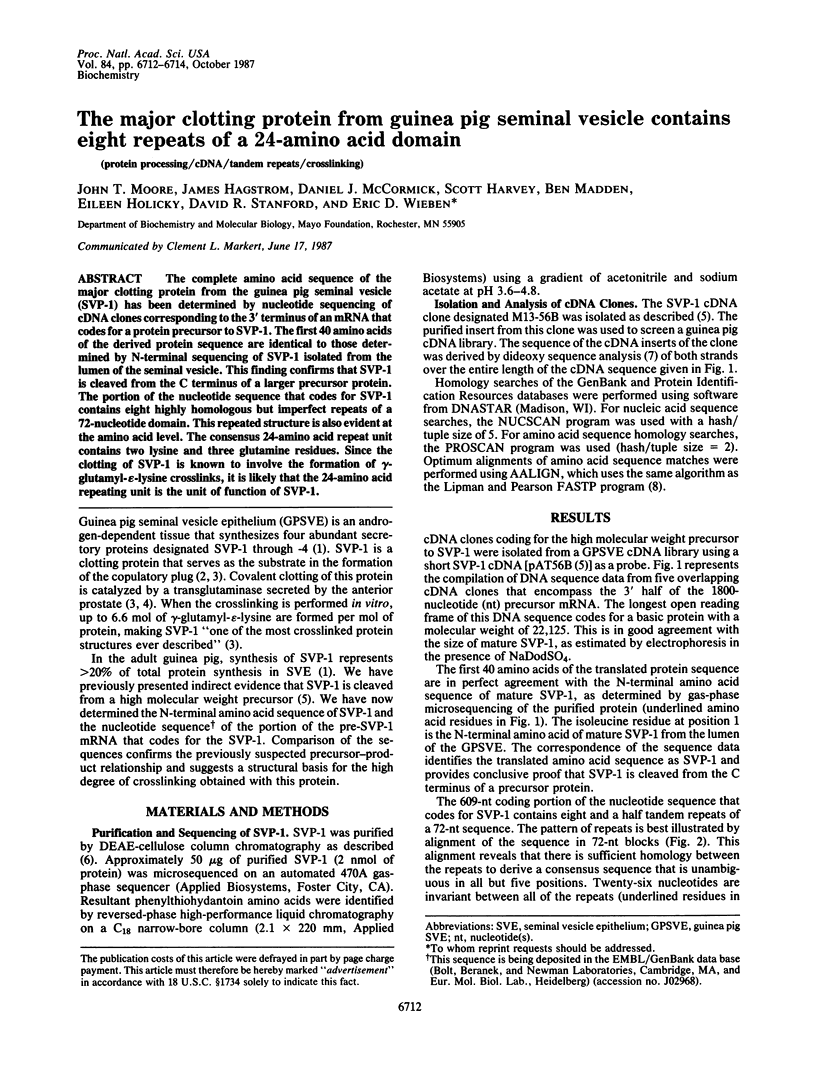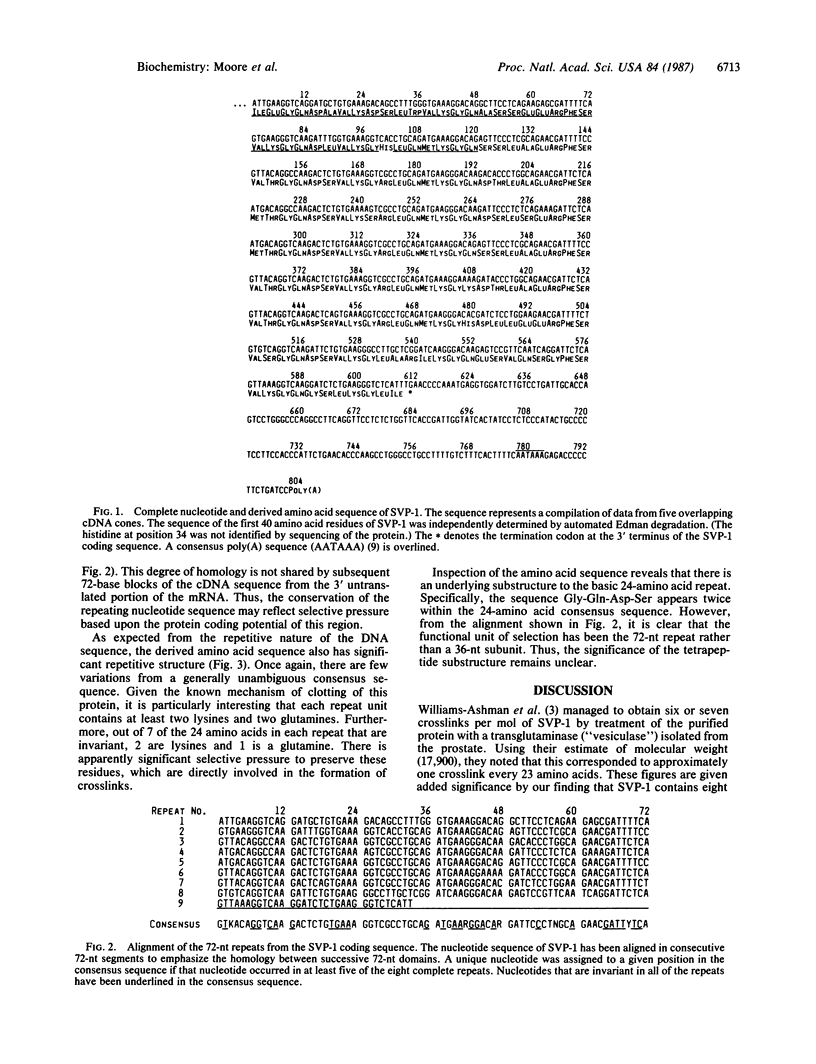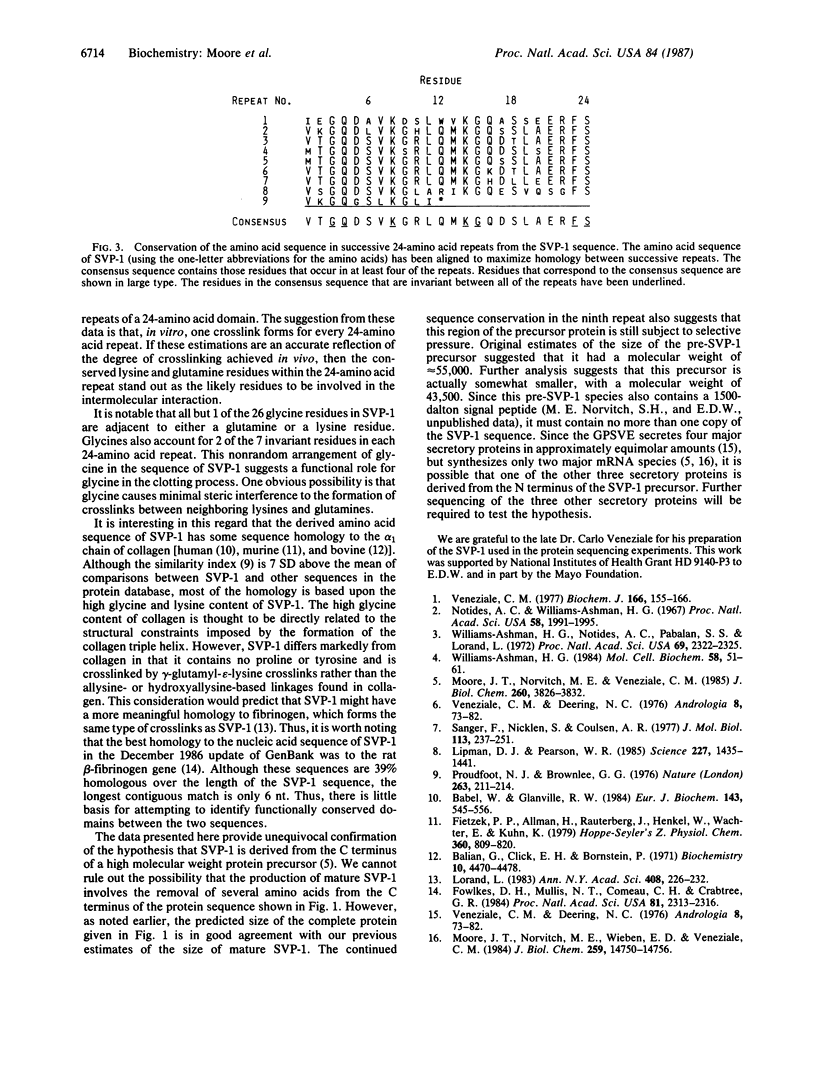Abstract
The complete amino acid sequence of the major clotting protein from the guinea pig seminal vesicle (SVP-1) has been determined by nucleotide sequencing of cDNA clones corresponding to the 3' terminus of an mRNA that codes for a protein precursor to SVP-1. The first 40 amino acids of the derived protein sequence are identical to those determined by N-terminal sequencing of SVP-1 isolated from the lumen of the seminal vesicle. This finding confirms that SVP-1 is cleaved from the C terminus of a larger precursor protein. The portion of the nucleotide sequence that codes for SVP-1 contains eight highly homologous but imperfect repeats of a 72-nucleotide domain. This repeated structure is also evident at the amino acid level. The consensus 24-amino acid repeat unit contains two lysine and three glutamine residues. Since the clotting of SVP-1 is known to involve the formation of gamma-glutamyl-epsilon-lysine crosslinks, it is likely that the 24-amino acid repeating unit is the unit of function of SVP-1.
Full text
PDF


Selected References
These references are in PubMed. This may not be the complete list of references from this article.
- Babel W., Glanville R. W. Structure of human-basement-membrane (type IV) collagen. Complete amino-acid sequence of a 914-residue-long pepsin fragment from the alpha 1(IV) chain. Eur J Biochem. 1984 Sep 17;143(3):545–556. doi: 10.1111/j.1432-1033.1984.tb08404.x. [DOI] [PubMed] [Google Scholar]
- Balian G., Click E. M., Bornstein P. Structure of rat skin collagen 1-CB8. Amino acid sequence of the hydroxylamine-produced fragment HA1. Biochemistry. 1971 Nov 23;10(24):4470–4478. doi: 10.1021/bi00800a019. [DOI] [PubMed] [Google Scholar]
- Fietzek P. P., Allmann H., Rauterberg J., Henkel W., Wachter E., Kühn K. The covalent structure of calf skin type III collagen. I. The amino acid sequence of the amino terminal region of the alpha 1(III) chain (position 1--222). Hoppe Seylers Z Physiol Chem. 1979 Jul;360(7):809–820. doi: 10.1515/bchm2.1979.360.2.809. [DOI] [PubMed] [Google Scholar]
- Fowlkes D. M., Mullis N. T., Comeau C. M., Crabtree G. R. Potential basis for regulation of the coordinately expressed fibrinogen genes: homology in the 5' flanking regions. Proc Natl Acad Sci U S A. 1984 Apr;81(8):2313–2316. doi: 10.1073/pnas.81.8.2313. [DOI] [PMC free article] [PubMed] [Google Scholar]
- Lipman D. J., Pearson W. R. Rapid and sensitive protein similarity searches. Science. 1985 Mar 22;227(4693):1435–1441. doi: 10.1126/science.2983426. [DOI] [PubMed] [Google Scholar]
- Lorand L. New approaches to old problems in the clotting of fibrinogen. Ann N Y Acad Sci. 1983 Jun 27;408:226–232. doi: 10.1111/j.1749-6632.1983.tb23247.x. [DOI] [PubMed] [Google Scholar]
- Moore J. T., Norvitch M. E., Veneziale C. M. The cDNA cloning of a 55-kilodalton protein from guinea pig seminal vesicle. Evidence that the protein is the precursor of a 25-kilodalton basic secretory protein. J Biol Chem. 1985 Mar 25;260(6):3826–3832. [PubMed] [Google Scholar]
- Moore J. T., Norvitch M. E., Wieben E. D., Veneziale C. M. Expression of a secretory protein gene during androgen-induced cell growth. J Biol Chem. 1984 Dec 10;259(23):14750–14756. [PubMed] [Google Scholar]
- Notides A. C., Williams-Ashman H. G. The basic protein responsible for the clotting of guinea pig semen. Proc Natl Acad Sci U S A. 1967 Nov;58(5):1991–1995. doi: 10.1073/pnas.58.5.1991. [DOI] [PMC free article] [PubMed] [Google Scholar]
- Proudfoot N. J., Brownlee G. G. 3' non-coding region sequences in eukaryotic messenger RNA. Nature. 1976 Sep 16;263(5574):211–214. doi: 10.1038/263211a0. [DOI] [PubMed] [Google Scholar]
- Rigby P. W., Dieckmann M., Rhodes C., Berg P. Labeling deoxyribonucleic acid to high specific activity in vitro by nick translation with DNA polymerase I. J Mol Biol. 1977 Jun 15;113(1):237–251. doi: 10.1016/0022-2836(77)90052-3. [DOI] [PubMed] [Google Scholar]
- Veneziale C. M., Deering L. C. Soluble proteins of guinea pig seminal vesicle lumen: purification and partial characterization. Andrologia. 1976;8(2):73–82. doi: 10.1111/j.1439-0272.1976.tb02112.x. [DOI] [PubMed] [Google Scholar]
- Veneziale C. M., Deering L. C. Soluble proteins of guinea pig seminal vesicle lumen: purification and partial characterization. Andrologia. 1976;8(2):73–82. doi: 10.1111/j.1439-0272.1976.tb02112.x. [DOI] [PubMed] [Google Scholar]
- Veneziale C. M. Specific protein synthesis in isolated epithelium of guinea-pig seminal vesicle. General features. Biochem J. 1977 Aug 15;166(2):155–166. doi: 10.1042/bj1660155. [DOI] [PMC free article] [PubMed] [Google Scholar]
- Williams-Ashman H. G., Notides A. C., Pabalan S. S., Lorand L. Transamidase reactions involved in the enzymic coagulation of semen: isolation of -glutamyl- -lysine dipeptide from clotted secretion protein of guinea pig seminal vesicle. Proc Natl Acad Sci U S A. 1972 Aug;69(8):2322–2325. doi: 10.1073/pnas.69.8.2322. [DOI] [PMC free article] [PubMed] [Google Scholar]
- Williams-Ashman H. G. Transglutaminases and the clotting of mammalian seminal fluids. Mol Cell Biochem. 1984;58(1-2):51–61. doi: 10.1007/BF00240604. [DOI] [PubMed] [Google Scholar]


